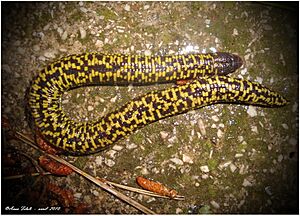Checkerboard worm lizard facts for kids
Quick facts for kids Checkerboard worm lizard |
|
|---|---|
 |
|
| Conservation status | |
| Scientific classification | |
| Genus: |
Trogonophis
|
| Species: |
wiegmanni
|
 |
|
The checkerboard worm lizard (Trogonophis wiegmanni) is a special kind of lizard that looks a bit like a worm. It belongs to a group called amphisbaenians. This lizard is the only species in its group (genus Trogonophis). You can only find it in North Africa.
This interesting creature lives in many places. These include temperate forests, areas with Mediterranean-type shrubs, and grasslands. It also likes sandy shores, arable land (farmed land), and pastureland (grazing land). Sadly, its home is shrinking, which puts it at risk.
Contents
Meet the Checkerboard Worm Lizard
The checkerboard worm lizard is also known as "Wiegmann's worm lizard." It gets its name from a German scientist, Arend Friedrich August Wiegmann. In French, it's called "Trogonophis." In German, it's known as "Schachbrett-Doppelschleiche" or "Wiegmanns Spitzschwanz Doppelschleiche."
Different Kinds of Checkerboard Worm Lizards
There are two main types, or subspecies, of the checkerboard worm lizard. You can tell them apart by their colors.
- Trogonophis w. wiegmanni has a pale yellow color.
- T. w. elegans is gray-white or light pink.
What Does It Look Like?
Both types of checkerboard worm lizards share some features.
- Head: Their head is rounded and a little flat from top to bottom. The snout (nose area) sticks out slightly. They have two pairs of protective plates on their head. Their nostrils open forward. They don't have outside ears. Their skull is longer than other worm lizards in their family.
- Body: Their body looks like a worm. It has no legs, is long, round, and has rings all over it. They have sunken lines on their sides. Their tail is short and cone-shaped. It cannot break off like some other lizards' tails. Their body is short and thick compared to other legless lizards. Both male and female lizards do not have special pores near their tail.
Where Does It Live?
The checkerboard worm lizard likes places with lots of leaf litter, sandy soil, and moist soil. It often hides under stones and other ground cover. You might also find it near roadsides or in traditional farming areas. It lives in oak forests, oak-juniper forests, and sandy spots without plants. It can also be found in steppe habitats.
This lizard can live in many different environments. These include temperate forests, shrubland, temperate grassland, and farmed lands. It has been found from sea level up to about 1,900 meters (6,234 feet) high.
Its home is in northern Algeria, western Morocco, the Chafarinas Islands (part of Spain), and northwestern Tunisia.
How Does It Behave?
You can often find these lizards under rocks or stones in their habitats. Sometimes, you might even find a pair together. However, lizards of the same sex usually don't share the same rock. This shows they prefer their own space. Female lizards seem to benefit when a male is nearby. This might mean the male helps keep watch or reduces problems from other males.
What Does It Eat?
The checkerboard worm lizard eats many different kinds of insects. It also enjoys other small creatures that live in the soil.
How Does It Have Babies?
The checkerboard worm lizard is viviparous. This means the mother gives birth to live young, instead of laying eggs.


